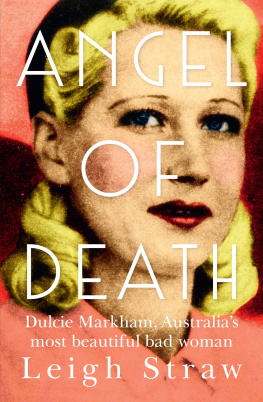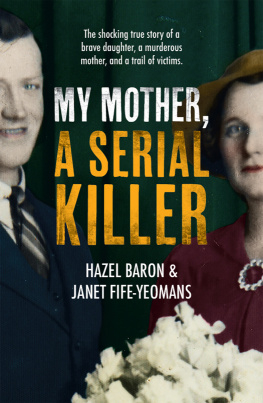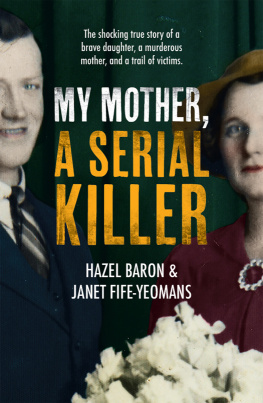Contents
Guide
Contents
For
Kristina Kotua
thank you for your friendship
and
Jack, Lawson and Riley,
my boys. Love always.
It was a cool Sydney evening on 6 August 1939 when, a little before eight oclock, twenty-five-year-old Dulcie Markham made the fateful decision to go to a party with her lover, Guido Calletti. Only one of them would survive the shooting a short while later.
Dulcie May Markham was the glamour woman of Australian crime, known on the streets as Pretty Dulcie. With soft, finger-waved blonde hair immaculately styled around the contours of her face, her ocean-blue eyes striking against her peaches and cream complexion and bright red lipsticked lips, she looked like a movie star and dressed like one too. She wore deep-red dresses to inquests and courtroom appearances, and brighter, flashier frocks for working the streets and brothels. She was one of Australias most famous prostitutes, but had impeccably bad taste in men.
Her lover that night in August 1939, Guido Calletti, was a notorious gangster with a long criminal record, known to knife or shoot his rivals. One-time leader of the Darlinghurst Push a gang of youths he had been put away many times for assault and for consorting with known criminals. Born into an Italian-Australian family in Eastwood, north-east of Sydney city, Guido seemed destined for prison from a young age. He lived by his fists and sometimes came off second best by 1939 his nose had been broken several times. As a kid, he was sent to a number of reformatories, but they did little to curb his path into crime. He became a con man, pimp and extortionist and, fascinated by the rising criminal underworlds of Sydney, wanted a piece of the action in the 1920s. During the heyday of Sydneys Razor Wars from 1927 to 1931, which turned the city into the most violent place in Australia, he was vicious and homicidal. He became a notorious gangster, with a long list of police detectives and criminal rivals intent on keeping him out of the crime business.
Dulcie Markham was more popular in Sydneys crime scene than Guido, and her notoriety far exceeded his. She kept close company with many gangsters in Sydney, and extended this to Brisbane and Melbourne in the 1930s. Leading magistrates and police detectives were convinced she was the real criminal operator behind the men with whom she claimed merely to associate.
Walking along Brougham Street to the party in August 1939, Dulcie was well suited to the area a notorious crime spot nestled within Woolloomooloo and Kings Cross. Brougham Street runs off William Street a main thoroughfare down into Kings Cross from Hyde Park and continues down from Kings Cross towards the harbour through Woolloomooloo. It is also a stones throw from Darlinghurst, aka Razorhurst. When organised crime developed in Sydney following World War I, these were its main areas of operation. Regular police raids on the rundown terrace houses turned up stolen goods, drug stashes and crooks on the run from the law. They also revealed people like Dulcie Markham, whose killer smile matched her deadly reputation.
Parties in houses on Brougham Street, like the one to which Dulcie and Guido were headed, were hard-drinking, loud-mouthed get-togethers combining illegal gambling with prostitution and often cocaine dealing. Cockatoos lookouts for the police were placed in the front rooms or on nearby street corners to give the call-out if a local constable was doing the rounds. Such parties were a risky affair after the introduction of new consorting laws in the late 1920s, which gave NSW Police the power to arrest anyone associating with a known criminal. If found guilty, they faced up to six months in prison.
Many of the old terraces and boarding houses along Brougham Street were demolished in the 1970s with the works for the Eastern Suburbs Railway and council efforts to rejuvenate the area, but redevelopment and renovations to the remaining terraces were slow in changing the streets seedy reputation. Sex workers still walked around looking for business on Brougham Street and nearby laneways into the 1990s. In his history of the suburb, Australian author and playwright Louis Nowra recalls how people would drive in reverse along the one-way street, often when drunk, not having the patience to drive along Cowper Wharf Road to enter it the right way.
The terrace at 16 Brougham Street was a standard one for the time. The front verandah gave straight onto the street, and the front door, to the right, led into a hall extending past a bedroom and along to the lounge area. There were stairs up to the next level, a kitchen flowing on from the lounge, and a toilet and other amenities outside. The backyard was flanked by a high quarry wall. The terrace balcony was mostly shaded with striped fabric that gave the occupants some privacy from the street especially, as would come to light in the investigations, when the room behind it was used for prostitution.
It was the kind of house where you would find members of the Brougham Street gang. They were notorious in Woolloomooloo and Kings Cross, and long-standing rivals of Dulcies lover, Guido. The police had been successful in breaking most of the gangs with the consorting laws, and while the worst of the Razor Wars violence was well and truly over by 1939, the Brougham Street gang continued to menace locals. They used standover tactics to maintain their hold over gambling, drinking and drugs in the area, taking a cut from the earnings of other criminal businesses operating nearby, and offering protection in return. It was thuggery cloaked in a form of protection from other crooks.
Guidos old scores had not been settled as Dulcie approached 16 Brougham Street. A man with a long memory, he was a violent ticking time bomb intent on reclaiming his hold on Kings Cross. While he planned to confront his rivals at the house party, his guest, Dulcie, was looking for a good time.
In the hours leading up to Guidos arrival at the house, birthday celebrations had been in full swing for one of the guests, Peggy Patterson. Her friends Flora Horton, Maude Beale and May McDonald put on lunch and drinks for her, and all became tipsy with the festivities. They kicked on past lunch and were joined by other women and two labourers, George Allen and Robert Branch, both members of the Brougham Street gang. Lunch turned into dinner and the party roared on.
It was a gathering of many criminal identities where everyone had an alias. Robert Branch was also Robert Jackson, George Allen used the name George Cave, and May McDonald also went by May McIvor. Her husband, John McIvor, also used McDonald as an alias.
The mood of the party changed immediately when Guido showed up. Drunk and uninvited, he brought along friends from an earlier football match, where they had also been drinking. While at the game, he had pulled out two firearms; he hadnt fired at anyone, but he had worried his friends all the same. Guido was gearing himself up to take on members of the Brougham Street gang. He was up for a fight.
There was conflicting evidence about whether Dulcie and Guido arrived together. Maude Beale would later state that Guido arrived first and Dulcie walked in shortly after with one of his mates. While Guido was unwelcome, Dulcie seemed at ease in the house, wandering through to the back and striking up a conversation with some of the women there, including May, Peggy and Maude.
Next page







